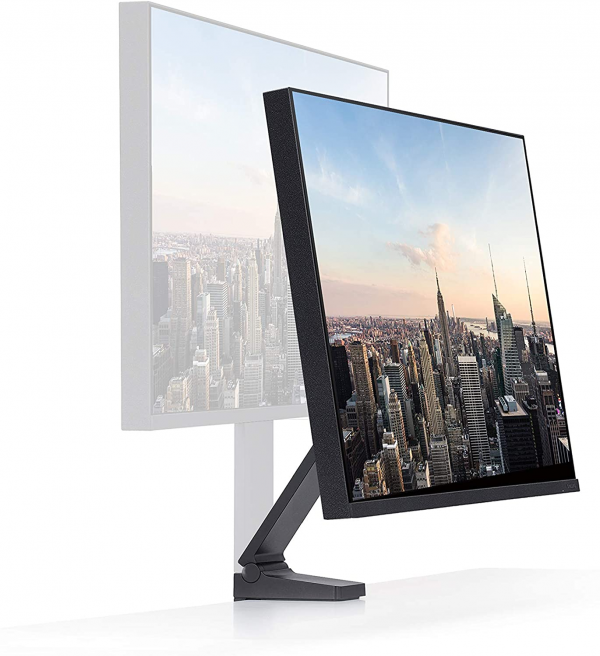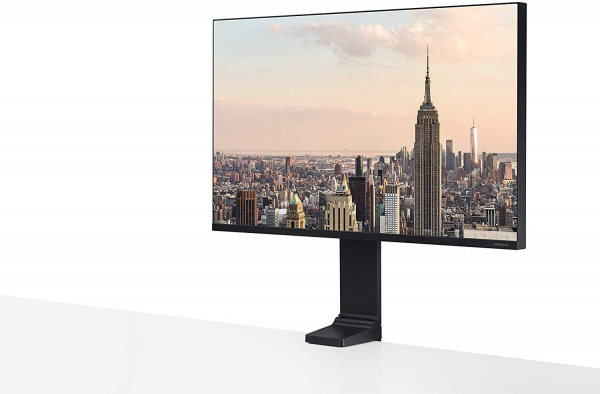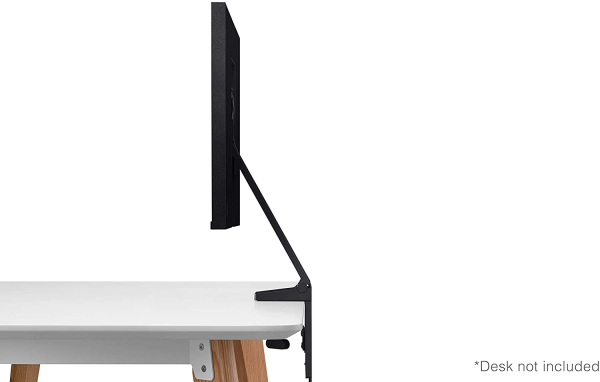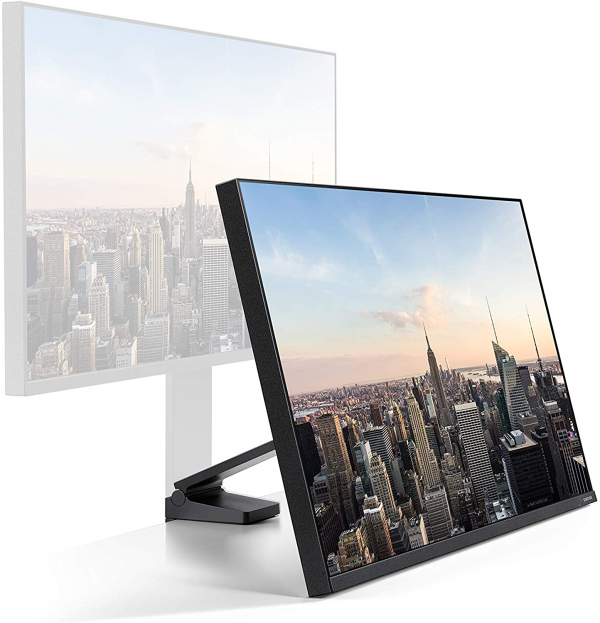Samsung
Samsung Space Monitor S32R750UEU: a 32-inch Ultra HD "footless" monitor
Aprox. 399€
See specificationsThe Samsung S32R750UEU is a fairly original monitor whose foot is pinched on the back edge of the desk to free up space. It remains to be seen in this test if the image quality is there ...
Positive points
Original design freeing up space on the desk.
Image quality.
Contrast compared to an IPS monitor.
Reactivity.
Display delay.
Bad points
Limited connectivity.
No USB hub.
Height adjustment linked to that of the inclination.
Our review
Presentation
The Samsung S32R750UEU monitor has a 32 inch VA panel with an Ultra HD resolution of 3 840 x 2 160 px. The manufacturer announces a maximum brightness of 300 cd / m², a contrast of 2,500: 1, viewing angles of 178 ° and a response time of 4 ms. This model stands out above all with its original stand that pinches the desk and thus saves a lot of work space. On this point, it is clearly an innovation on the monitor market and it avoids buying a mounting arm separately.
The Samsung S32R750UEU monitor is sold for around € 450, but it is sometimes on sale for less than € 350, which is then a great deal for a 32-inch Ultra HD monitor. Samsung has also announced the version for gamers, the Samsung Space Gaming Monitor which has the same characteristics, but swaps the VA Ultra HD 60 Hz panel for a 32 inch Quad HD panel (2,560 x 1,440 px) supporting a frequency of 144 Hz. And FreeSync.

Ergonomics
In our photo lab, the Samsung Space Monitor is just a simple monitor. To see a difference with a classic screen, you have to look at the foot.
As the photo on the left shows, the stand allows you to fully stick the screen to the wall thanks to a cable pass system in the stand. On the other hand, the screen only offers a partial adjustment of the height and the inclination. If the screen can be lowered, it is necessary to bring it closer to yourself and change its inclination. It is then 39 cm from the wall, which can prevent the use of a keyboard on a narrow desk, for example. Conversely, glued to the wall, it completely frees up space, but its height is then fixed at 21 cm above the desk.
The fixing system adapts to almost all types of desks from 1 to 9 cm thick (and 95 mm minimum depth). The metal plate can be moved to three positions and adjustment is done by hand with the clamping screw.
The foot still protrudes 1 cm at the back and the desk can not be completely glued to a wall. However, it is very discreet on the desk, with only 10 cm deep for a few centimeters wide.
The back is sober and the black plastic of good quality. The connection is on the side so that you can place the monitor completely on the wall. Note that we do not have the original cable on the photos. Samsung provides a single Y-cable for the power supply and the HDMI input, which frees up the second channel for the DisplayPort cable.
Connectivity is limited since you have to settle for an HDMI 2.0b input and a mini-DisplayPort input. The USB port is only there for after-sales service. We would have liked to see two additional USB ports on the edge of the monitor, for example. The monitor also skips the speakers and headphone output.
A joystick to do everything [/ media]
The Samsung monitor uses a single joystick to power up and access the various settings. The joystick remains the most efficient way for us to access all the settings very quickly.
The latest versions of operating systems like Windows 10 or macOS 10.4 handle Ultra HD definition perfectly and allow efficient scaling to 150% on this 32-inch panel. The text elements are large enough to be readable and the image is perfectly clear. On a 32 inch diagonal, it is possible to use the native definition of 3 840 x 2 160 px without scaling with a distance of between 60 and 80 cm from the screen. Note that photo editing software like Photoshop perfectly manages this scaling in the interface, but display photos using the native definition of the panel, which allows you to benefit from a very high level of detail and appreciable for photo editing enthusiasts.
It is possible to advance the screen a lot, but it is then very close to the eyes. It would almost make you want to use it with a stylus to draw on it. Unfortunately, it is not tactile.
By lowering the brightness to 28 to obtain a white at 150 cd / m², the Samsung Space Monitor S32R750UEU consumes 27 W, ie a relative consumption of 96 W / m², close to the average consumption of the monitors tested (around 100 W / m² ). It consumes at least 14 W of brightness (16 cd / m²) and 44 W at 326 cd / m².

Colors and contrast
By default, the Samsung S32R750U is fairly well calibrated. We have measured an average temperature of 6,730 K, close to the 6,500 K reference, and this, with a stable curve over most of the spectrum. The gamma is at 2.1, close to the reference 2.2, with a curve which is also fairly stable. Delta E 2.3 is synonymous with true colors. Remember that the human eye no longer perceives the difference between the colors requested and the colors displayed when the colorimetric drift (the delta E) is less than 3. The Samsung monitor does very well here since only three colors see their delta E exceed 3, while remaining less than 4.
After some very simple adjustments (lower the brightness to 28 to obtain a white close to 150 cd / m², we get similar results. The temperature is still a little closer to the 6,500 K reference, but the colors are slightly less The decrease in brightness therefore does not vary the display quality too much, which is a good point.
The calibration of the screen using a probe above all makes it possible to smooth the gamma and temperature curves which are now perfectly stable, with averages very close to the reference values. The color rendering is further improved (average delta E at 1.9), but red, green and yellow retain a delta E greater than 3. You can download this color profile by following this link.
The contrast of 2020: 1 is fairly average for a VA panel; the best VA monitors on the market, such as the Philips Momentum 436M6 or the MSI Optix MAG271CR display a contrast ratio of 4,000: 1. However, this contrast remains better than that of IPS monitors and makes it possible to deliver fairly deep blacks.
The average difference in white homogeneity is only 6% on the 32-inch panel. There is thus no variation in the brightness perceptible to the eye. We did not find any light leaks in the corners or any clouding ("cloud effect") on our test model. VA technology also offers good viewing angles, even if there is a decrease in brightness when the angle becomes too large.

Reactivity
Good news, this monitor does not use Pulse Width Modulation (PWM) to vary the light intensity and is therefore flicker-free, a phenomenon that can cause headaches to the most sensitive people. The screen also has a software blue light filter that reduces the color temperature for a warmer rendering.
We measured the afterglow time at 9.5 ms with the overdrive set to "Fast". This setting limits ghosting (drag effect behind the image) while avoiding the reverse ghosting effect (negative drag) that appears with the "Time Lapse" setting. This reactivity allows him to adapt to all situations and in particular to do fairly well in video games - even if it is not really what is asked of him. Finally, we measured the delay in the display (input lag) at 10.9 ms (at 60 Hz). There is therefore no lag between the action with the mouse and its repercussion on the screen.
Conclusion
The Samsung Space Monitor S32R750UEU has an original design that frees up space on the desk thanks to its ingenious arm and cable passage. And the image quality is not to be outdone, very good right out of the box, without the need for calibration. The Samsung Space Monitor deserves all the same a little more provided connectors (USB and USB-C) and an improvement of the orientation system of the panel to make it independent of the height.
Specifications

